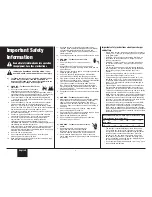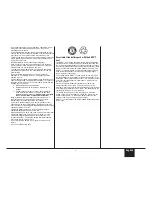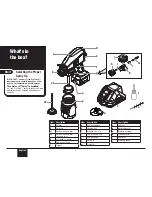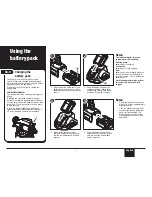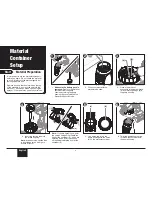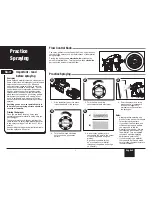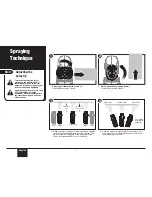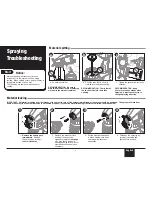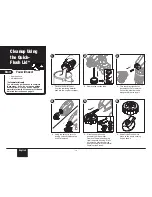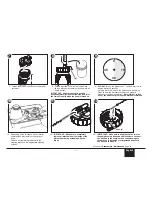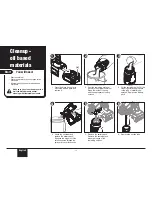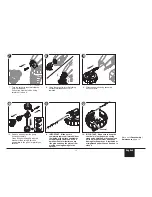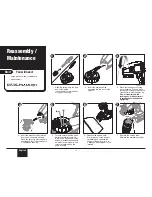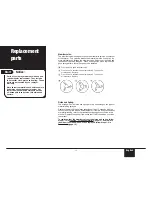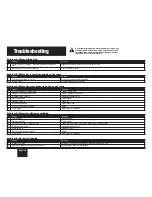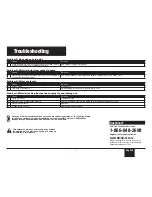
English
2
Safety
Safety
Important Safety
Information
Read all safety information before operating
the equipment. Save these instructions
Indicates a hazardous situation which, if not
avoided, could result in death or serious injury.
a) To reduce the risks of fire or explosion, electrical shock
and the injury to persons, read and understand all
instructions included in this manual. Be familiar with the
controls and proper usage of the equipment.
b) WARNING - To reduce the risk of fire or
explosion:
1. Do not spray flammable or combustible
materials near an open flame, pilot lights
or sources of ignition such as hot objects, cigarettes, motors,
electrical equipment and electrical appliances. Avoid creating
sparks from connecting and disconnecting power cords.
2. For units intended for use with only water-based materials
— Do not spray or clean with flammable liquids. For use with
water-based liquids only.
3. For units intended for use with only water-based or mineral
spirit-type materials with a minimum flash point of 21ºC
(69.8ºF) — Do not spray or clean with liquids having a flash
point of less than 21ºC (69.8ºF). Flash point is the temperature
at which a fluid can produce enough vapor to ignite.
4. Verify that all containers and collection systems are grounded
to prevent static discharge.
5. Connect to a grounded outlet and use grounded extension
cords (electric models only). Do not use a 3 to 2 adapter.
6. Do not use a paint or solvent containing halogenated
hydrocarbons. Such as chlorine, bleach mildewcide,
methylene chloride and trichloroethane. They are not
compatible with aluminum. Contact the coating supplier about
compatibility of material with aluminum.
7. Keep spray area well ventilated. Keep a good supply of fresh
air moving through the area to keep the air within the spray
area free from accumulation of flammable vapors. Keep pump
assembly in well ventilated area.
8. Do not smoke in the spray area.
9. Do not operate light switches, engines, or similar spark
producing products in the spray area.
10. Keep area clean and free of paint or solvent containers, rags,
and other flammable materials.
11. Know the contents of the paint and solvents being
sprayed. Read all Material Safety Data Sheets (MSDS)
and container labels provided with the paints and
solvents. Follow the paint and solvent manufacturer’s
safety instructions.
12. Fire extinguisher equipment shall be present and working.
c) WARNING - To reduce the risk of skin
injection:
1. Do not aim the gun at, or spray any person or
animal.
2. Keep hands and other body parts away from the
discharge. For example, do not try to stop leaks with any
part of the body.
3. Always use the nozzle tip guard. Do not spray without the
nozzle tip guard in place.
4. Only use a nozzle tip specified by the manufacturer.
5. Use caution when cleaning and changing nozzle tips.
6. High-pressure spray is able to inject toxins into the body
and cause serious bodily injury. In the event that injection
occurs, seek medical attention immediately.
7. This system is capable of producing 2800 PSI / 193
Bar. Only use replacement parts or accessories that
are specified by the manufacturer and that are rated a
minimum of 2800 PSI. This includes spray tips, nozzle
guards and extensions.
8. Verify that all connections are secure before operating the
unit.
d) WARNING - To reduce the risk of injury:
1. Always wear appropriate gloves, eye protection, clothing
and a respirator or mask when painting. Hazardous
vapors – Paints, solvents, insecticides, and other
materials can be harmful if inhaled or come in contact
with body. Vapors can cause severe nausea, fainting or
poisoning.
2. Do not operate or spray near children. Keep children
away from equipment at all times.
3. Do not overreach or stand on an unstable support. Keep
effective footing and balance at all times.
4. Stay alert and watch what you are doing.
5. Do not operate the unit when fatigued or under the
influence of drugs or alcohol.
e) WARNING - To reduce the risk of electric
shock:
1. Keep electrical cord plug and spray gun
trigger free from paint and other liquids.
Never hold cord at plug connections to support cord.
Failure to observe may result in an electrical shock.
2. Never immerse electrical parts in water or any other
liquid. Wipe the exterior of the sprayer with a damp cloth
for cleaning.
Important safety instructions about your charger
and battery
• Before using charger, read all instructions and cautionary
markings on (1) charger, (2) battery pack, and (3) product
using battery pack.
• DANGER: 120 volts present at charging terminals. Do
not probe with conductive objects. Danger of electric
shock or electrocution.
• DANGER: If battery pack case is cracked or damaged,
do not insert into charger. Danger of electric shock or
electrocution.
• The charger and battery pack are specifically designed
to work together. DO NOT attempt to charge the battery
pack with any chargers other than the ones in this
manual.
• Do not recharge battery in damp or wet environment.
• Do not expose the charger to rain or snow.
• Charge battery pack in temperatures above 40ºF (4ºC)
and below 105ºF (41ºC). Store tool and battery pack
in locations where temperatures will not exceed 120ºF
(49ºC). This is important to prevent serious damage to
the battery cells.
• These chargers are not intended for any uses other than
charging Titan rechargeable batteries. Any other uses
may result in risk of fire, electric shock, or electrocution.
• To reduce risk of damage to electric plug and cord, pull by
plug rather than cord when disconnecting charger.
• Make sure cord is located so that it will not be stepped on,
tripped over, or otherwise subjected to damage or stress.
• An extension cord should not be used unless absolutely
necessary. Use of improper extension cord could result in
risk of fire, electric shock, or electrocution.
• An extension cord must have adequate wire size (AWG
or American Wire Gauge) for safety. The smaller the
gauge number of the wire the greater the capacity of the
cable, that is 16 gauge has more capacity than 18 gauge.
When using more than one extension to make up the total
length, be sure each individual extension contains at least
the minimum wire size.
Recommended Minimum AWG Size for Extension Cords
Total extension cord length (feet)
25
50
75
100
125
150
175
Wire gauge
18
18
16
16
14
14
12
• The charger is ventilated through slots in the housing.
Do not place any object on top of charger or place the
charger on a soft surface that might block the ventilation
slots and result in excessive internal heat. Place the
charger on a flat, non-flammable surface in a position
away from any heat source. If smoke or melting of the
case are observed, unplug the charger immediately and
do not use battery pack or charger.
• Do not operate charger with damaged cord or plug - have
them replaced immediately.


